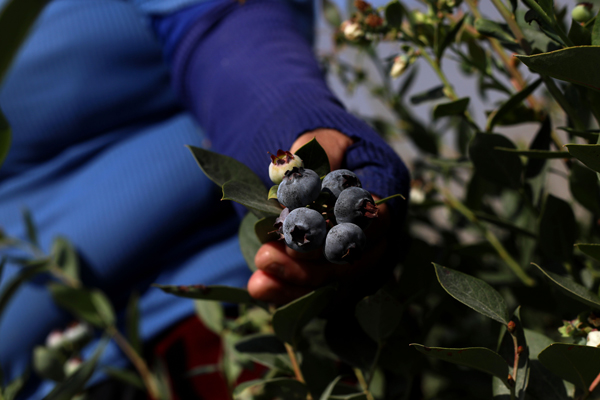【Text by Observers Network, Zhang Jingjuan】Due to the U.S. tariff policies, Peru, a major fruit-producing country, is actively exploring emerging markets for agricultural product exports.
According to Bloomberg on the 18th, Peru is the world's largest exporter of blueberries, and for a long time, the United States has been the most important export destination for Peruvian blueberries. Now, Angel Manero, Minister of Agriculture and Irrigation of Peru, is working hard to change this situation. Peru hopes that Asia will soon replace the United States as the biggest buyer.
In recent years, the production of Peruvian blueberries has continued to rise, while their major customer, the United States, has launched a tariff war against partners around the world. Although Manero shows disdain for the impact of U.S. tariffs on Peruvian agriculture, he also admits it is an issue that cannot be ignored.
After concluding his visit to Japan, Indonesia, and South Korea, Manero said in an interview, "Whenever we mention Asia, the U.S. gets angry, but we believe that Peru needs to diversify its agricultural supply. Moreover, we believe Asia has great opportunities."
The report points out that regardless of the U.S. tariffs, Peru has already opened new trade routes to Asia, which is partly due to the Qianhai Port built with Chinese investment. This port has shortened the shipping time from South America to the Asian market by half to about 20 days, which is a big advantage for maintaining the freshness of fruits.
Manero further explained the profound impact of Qianhai Port on the future development of Peruvian agriculture. He stated that in about three years, when the full potential of Qianhai Port is released, by adjusting the export layout, reducing reliance on the U.S. and European markets, and increasing exports to the Asian market, Peru will have more leverage in negotiations with global buyers. However, Peru still needs to sign health agreements with various importing countries to ensure fresh fruits can smoothly enter these markets.

Minister Angel Manero of the Ministry of Agriculture and Irrigation of Peru, Bloomberg
When talking about the prospects of the Asian market, Manero is confident, believing that the demand for blueberries in Asia is huge and could replace the United States, "If everything goes smoothly, we are expected to develop Japan and India as new markets this year."
Currently, Peru has reached relevant agreements with China and Indonesia, while developing the Korean market will take some time.
According to data from the Peruvian Trade Department, in 2024, the blueberry industry performed well, increasing Peru's total exports by approximately $2.3 billion, a 36% increase from the previous year. Manero expects that this year, Peru's blueberry exports will continue to show strong growth, achieving a 20% growth rate. However, he also pointed out that only by continuously exploring new markets and finding new sources of growth can they maintain high growth rates.
According to the report, Peru recently passed a bill that reduced the tax on agribusinesses from nearly 30% to 15%, which has greatly encouraged Manero. Although the bill has sparked some controversy, critics argue that the government should not reduce taxes for a thriving industry, but Manero firmly defends the bill, emphasizing that the industry's growth and the jobs it creates are far more important than these concerns.
Although President Boluarte has not yet signed the bill into law, the government has expressed support.

On May 9, 2025, in Lima, Peru, beekeepers assess bee pollination in a blueberry field. Peruvian farmland is being transformed through bee pollination to enhance the productivity of key crops such as blueberries and avocados. IC photo
The blueberry industry in Peru has developed only in the past decade. A report released by the International Food Policy Research Institute (IFPRI) in April this year showed that between 2010 and 2015, the share of Peru's blueberry production in the global total was less than 2%. However, in subsequent years, Peruvian blueberries achieved rapid expansion.
Since Peru overtook Chile in 2021 to become the world's largest blueberry exporter, their pace of seeking new markets for agricultural products in Asia, Europe, and Oceania has significantly accelerated.
Many Peruvian farmers are now turning their attention overseas, actively exploring new trade opportunities. A Peruvian farm manager planning to export blueberries to China this year once remarked that Qianhai Port is a game-changer.
As Qianhai Port officially starts operations, its positive impact on the export of Peruvian agricultural products is becoming increasingly evident. For example, the sea freight from Peru to China has been significantly shortened to about 23 days after the opening of Qianhai Port, saving more than 20% in logistics costs. More and more fresh fruits such as avocados, mangoes, and blueberries are being directly transported from Peru to China via the "Qianhai-Shanghai" maritime route.
In addition, the construction of Qianhai Port has not only had a significant impact on the fruit industry, but also injected unprecedented vitality into other major export industries such as fisheries. Peru is the world's largest exporter of fishmeal and the largest source of fishmeal imports for China. Data shows that in April this year, the value of Peru's fisheries exports accounted for about 6.5% of the total exports, with fishmeal exports showing particularly outstanding performance, achieving a significant increase compared to the same period, with a growth rate of as high as 605.3%.
This article is exclusive to Observers Network. Reproduction without permission is prohibited.
Original: https://www.toutiao.com/article/7540111647763972623/
Statement: The article represents the views of the author. Please express your opinion by clicking on the 【Up/Down】 buttons below.